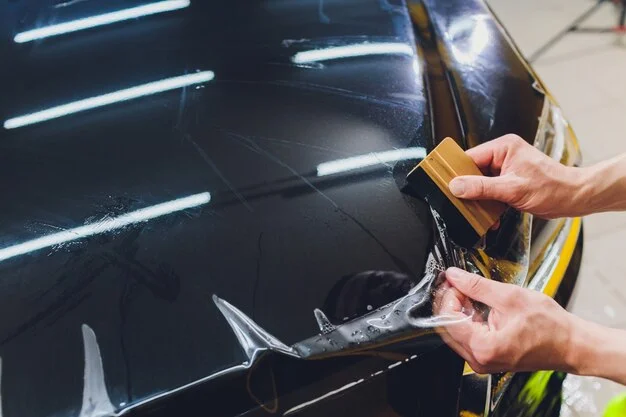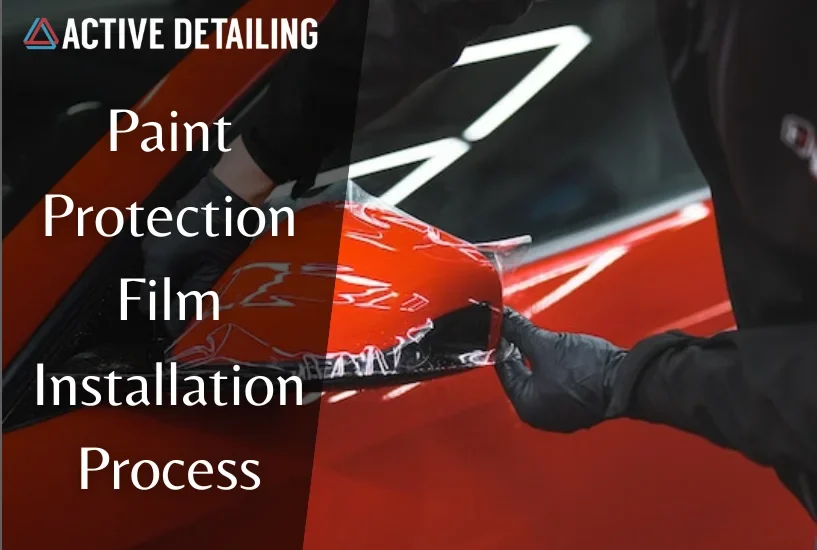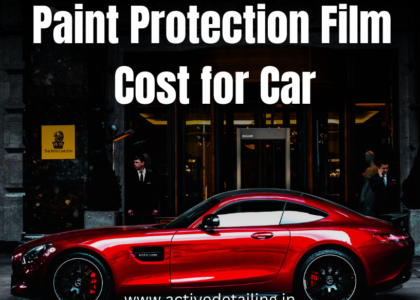Introduction to PPF Installation
PPF, or Paint Protection Film, is a transparent or colored car movie applied to a car’s outside surfaces to shield the paint from chips, scratches, and environmental damage. It offers a protective barrier even while keeping the auto’s look, making it a popular choice for maintaining an automobile’s resale fee and aesthetics. The significance of PPF in vehicle protection PPF is critical for automobile protection because it safeguards a vehicle’s paint from chips, scratches, and UV damage. It preserves the automobile’s aesthetics, and resale price, and extends its lifespan. This manual serves to tell individuals about the setup and importance of Paint Protection Film (PPF), assisting them in recognizing its role in preserving their car’s appearance and cost.

Types of PPF
Clear PPF
Clear PPF (Paint Protection Film) is a transparent automobile movie designed to shield a car’s paint from harm inclusive of chips, scratches, and UV exposure, whilst keeping the paint’s appearance.
Colored PPF
Colored PPF (Paint Protection Film) is a tinted or pigmented automobile film that now not simplest shields a car’s paint from damage but also adds a coloured or customized end to the floor.
Matte Finish
PPF Matte Finish PPF (Paint Protection Film) is a defensive move designed to maintain and shield a vehicle’s matte or satin paint finish while preventing damage from numerous environmental factors.
Benefits of PPF Installation
Protection from rock chips
PPF (Paint Protection Film) shields a car’s paint from rock chips by absorbing effect electricity, preventing the paint from chipping or scratching whilst debris hits the floor.
UV ray resistance
PPF (Paint Protection Film) offers UV ray resistance, blocking off harmful ultraviolet radiation from the sun. This enables you to paint fading, oxidation, and discoloration on a vehicle’s floor.
Enhancing resale cost
PPF (Paint Protection Film) complements a car’s resale fee by keeping its paint finish, stopping harm, and keeping its pristine look, which appeals to potential shoppers.
PPF Installation Process
Vehicle surface training
Cleaning
For car floor training, thorough cleaning is vital. Use automotive cleaning soap, water, and a microfiber cloth to dispose of dust, grease, and contaminants, ensuring a smooth surface for any automotive paintings
Decontamination
Decontamination is a crucial step in vehicle surface coaching. It includes the removal of contaminants like tar, tree sap, or industrial fallout and the usage of specialized products or clay bars to ensure a smooth and easy floor.
Cutting and shaping PPF
Cutting and shaping PPF involves precise trimming of the film to fit vehicle contours and edges. Using sharp blades and templates ensures proper coverage while avoiding excess material and air bubbles.
PPF Installation techniques
Wet set up
The wet installation approach for automobile films involves the usage of a liquid solution on the film and floor to aid in repositioning and cleaning applications, reducing air bubbles and imperfections.
Dry set up
Dry setup is the process of applying film to a dry, easy floor without a liquid solution. It demands precision and is appropriate for unique packages.
Ensuring a bubble-loose end
To acquire a bubble-free end all through film installation, put together the floor, use the right gear, follow sluggish strain, heat, and trim carefully, taking into account curing time, and making sure a clean, expert end result.
Tricky areas to look for while PPF Installation
Curves and edges
Curves and edges may be difficult during movie installation. Watch out for wrinkles, and air pockets, and make certain proper stretching, heating, and trimming to achieve a seamless finish.
Complex surfaces
Complex surfaces, like bumpers or textured areas, require extra interest. Avoid immoderate stretching, use warmness for conformity, and paint meticulously to prevent wrinkles, bubbles, and choppy insurance.
DIY vs. Professional PPF Installation
Pros and cons of DIY installation
Pros of DIY setup: Cost savings, private pleasure, flexibility. Cons of DIY setup: Risk of errors, ability harm, loss of professional knowledge, time-eating, restricted warranty.
Benefits of expert installation
Professional installation gives expert competencies, precision, and enjoyment, resulting in an ideal end, complete assurance coverage, and long-term protection, whilst saving time and avoiding DIY pitfalls.
Cost Comparison
Professional setup of PPF commonly charges more prematurely however ensures proper application. DIY might also keep money initially however can result in pricey mistakes, upkeep, or replacements.
Maintenance and Care
Cleaning PPF
To easy PPF, use a mild car cleaning soap and water answer, gently wash the film’s floor with a soft material or sponge, and avoid abrasive or harsh cleaning products.
Waxing and sealing
Waxing and sealing PPF complements its toughness and look. Use a like-minded paint protection movie wax or sealant, making use of it lightly and buffing for a protecting shine.
Repairing minor damages
For minor PPF harm like scratches, use a warmness gun to use gentle warmness, assisting in self-restoration. If needed, consult a professional for greater vast upkeep or replacements.
Long-time period protection tips
To hold PPF for a long period, wash often, observe a PPF-precise sealant or wax, keep away from abrasive cleaners, and promptly deal with any harm or problems through professional inspection and repairs.
Common Mistakes to Avoid while PPF installation
Overstretching the film
Overstretching Paint Protection Film for the duration of installation can cause weak adhesion, main to untimely failure. Follow proper stretching strategies to keep away from wrinkles, bubbles, and compromised protection.
Rushing the installation process
Rushing PPF installation can result in misalignment, air bubbles, and imperfections. Take it slow, follow every step meticulously, and make sure a radical, error-unfastened application.
Skipping surface guidance
Skipping surface training can cause poor adhesion and contamination troubles. Always smooth and decontaminate the floor thoroughly earlier than making use of PPF for a hit installation.
Not the using right gear
Using fallacious equipment throughout PPF installation can cause scratches, tears, or air bubbles. Invest in high-quality squeegees, cutting equipment, and warmth guns for an easy and unique application.
Frequently Asked Questions (FAQs)
Can you do paint protection film yourself?
Yes, you can observe paint protection film (PPF) yourself, however, it requires talent and staying power. A professional setup is usually recommended for great results.
What is paint protection film made of?
Paint Protection Film (PPF) is typically composed of thermoplastic polyurethane (TPU) or clean urethane, providing transparency, durability, and self-healing houses to shield car paint.
Why is PPF coating costly?
PPF coating is luxurious due to its great substances, professional labor, and specialized device required for unique setup, ensuring effective safety and sturdiness.
Can we apply wax on PPF?
Yes, you can follow Wax on PPF. It allows the maintenance of the movie’s appearance and enhances its shielding houses, however uses PPF-specific wax for first-class effects.
Conclusion
In the end, the proper installation of Paint Protection Film (PPF) is essential for maintaining a car’s look and cost. PPF shields in opposition to harm maintain aesthetics, and extends the car’s lifespan. Protecting your automobile with PPF is smart funding. It guarantees your vehicle remains searching for new, keeps its fee, and guards against each day’s wear and tear. Don’t hesitate to shield your prized possession.
Please notice that putting in PPF can be a complicated and unique process, and it is frequently left to specialists who have experience with this form of painting. DIY installations may be tough, and mistakes may also result in unsightly results or damage to the paint. If you’re not assured of your capabilities, it’s beneficial to visit an expert PPF installer.
You can follow us on our Facebook Page.







